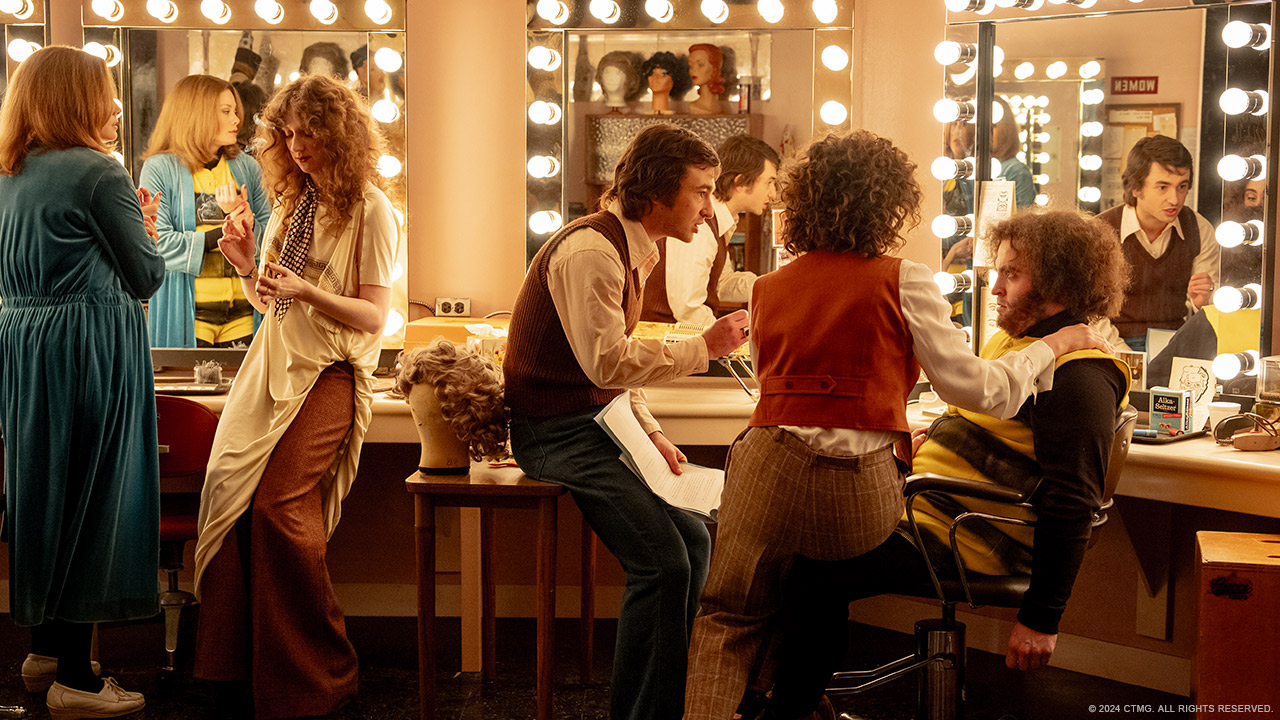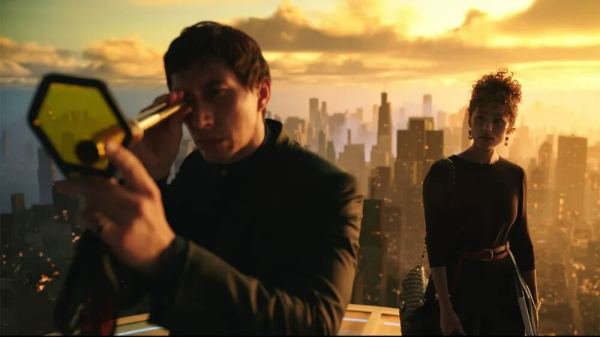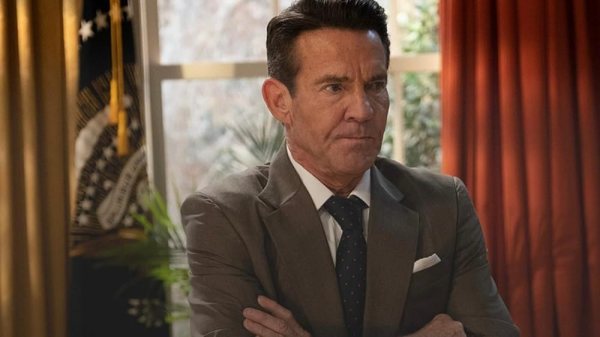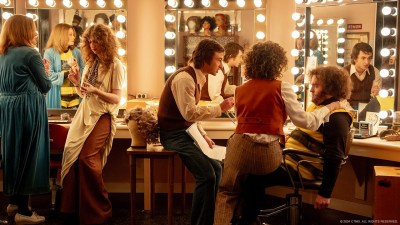Lorne Michaels, the creator and longtime producer of Saturday Night Live, has made many cameos in the show’s sketches since it first aired nearly 50 years ago. And with the notable exception of when he shared a tub with fellow Canadian Tom Green, he’s generally appeared well-dressed, sophisticated, and imperious—but he’s never the star. His film appearances have been even more modest: Of the many films he’s produced based on SNL sketches or showcasing SNL talent, he has cameos in only two.
That changes with Saturday Night, Jason Reitman’s new film about the debut of America’s favorite consistently disappointing TV show. Michaels is finally the hero, with the show’s stars relegated to his supporting players or even obstacles in his efforts to get his vision on the air.
The movie is set on October 11, 1975, the night of the groundbreaking show’s premiere, as chaos reigns in Studio 8H of 30 Rockefeller Center. A lighting rig nearly crushes two cast members. The lighting director quits. A prop sofa catches fire. A network executive threatens to keep the show from airing. Union workers won’t help with the set. There are too many sketches scheduled. Oh, and the guest host refuses to appear in a sketch—and then suffers lockjaw from the coke he’s been snorting.
And then there’s the combustible cast. John Belushi (Matt Wood) doesn’t like his costume and won’t sign his contract. Garrett Morris (Lamorne Morris, no relation) doesn’t know why he’s been hired. Chevy Chase (Cory Michael Smith) is already dreaming of his own talk show (spoiler alert: 18 years later, it doesn’t go well) but worries that he can’t measure up to Milton Berle. And that’s only half of the Not Ready for Prime Time Players. Stylistically, the film’s hand-held cinematography and percussion-heavy score heighten the tension, stress, and excitement. Plus, collars with a condor’s wingspan and the film’s washed-out colors make it feel like the 1970s, for better and worse.
The film takes place in the 90 minutes before the show’s premiere, which presents some shortcomings. For one thing, it leaves little room for character development—but I’d much rather watch this than a conventional Lorne Michaels biopic. (Scene: Michaels at newsstand, flipping through a copy of TV Guide. Says to self, “The show still needs a name … how about … [looks at weekend listings] … Saturday Night!”) And the ensemble cast includes many noteworthy performances, including Gabriel LaBelle’s affable and composed depiction of Michaels and Rachel Sennott as his flirtatious, whip-sharp wife and co-writer Rosie Shuster. Smith is a dead ringer for Chase and conveys his cockiness nicely, while O’Brien looks enough like Belushi but needs to work on his single-eyebrow raise.
The standout performance, though, is Nicholas Braun (aka Cousin Greg from Succession), who shines as both Andy Kaufman and Jim Henson. His Henson pesters Michaels about a script for a Muppets sketch that’s supposed to air, which is appropriate: Saturday Night often feels like a live-action version of The Muppet Show, with Michaels as Kermit trying to produce a show despite set problems and cast quirks.
Though the humor of Saturday Night doesn’t reach the heights of a classic SNL bit, at least it avoids the depths of the very worst sketches or episodes. Regular viewers will know what I mean: For every great sketch, the kind you and your friends quote for weeks (if not years) afterward, there are dozens of duds. People tend to like SNL more for what it could be or has been rather than what it usually is. To its credit, the film is certainly more consistent than the show’s actual first episode, the highlight of which is the superb musical performances of Billy Preston.
Longtime SNL fans will enjoy classic (if anachronistic) Easter eggs that foreshadow the show’s greatness. There’s a box of Colon Blow cereal in the writer’s room, even though the Phil Hartman parody commercial didn’t air until 1989. Dan Aykroyd (Dylan O'Brien) tries out his male prostitute character, who would appear in Season 4. And future disgraced senator Al Franken (Taylor Gray) and his writing partner Tom Davis (Mcabe Gregg) experiment with the effects for Aykroyd’s 1978 Julia Child bit.
The film takes other understandable liberties to heighten the tension and dramatize Michaels’s tenacity. Talent director Dave Tebet (Willem Dafoe) wasn’t nearly as standoffish as he’s portrayed here; in reality, his biggest beef was that George Carlin (the coked-up guest host) was wearing a T-shirt. Writer Alan Zweibel (Josh Brener), hired here at the last minute, had already been on board. Morris and Laraine Newman (Emily Fairn) are much more crucial to this plot than they were to the early success of the show, while comedy legends Gilda Radner (Ella Hunt) and Jane Curtin (Kim Matula) have relatively minor parts in the film. And writers took the easy way out by making the NBC censor like the Church Lady instead of basing a character on the show’s longtime and likable censor, Bill Clotworthy.
Throughout the film, Michaels struggles to explain what he wants this show to be. He has a vision, but he lacks an elevator pitch. Eventually, though, he’s able to articulate it: He wants the show to evoke the atmosphere of New York City on a weekend night—the promise, the excitement, the unpredictability.
That unpredictability remains a big reason SNL continues to draw viewers. As Christian Schneider and Scot Bertram like to point out in their great podcast about the show, SNL is always risky and dangerous by virtue of being live, even when the humor isn’t necessarily edgy. Saturday Night certainly captures that sense.
Though SNL isn’t the longest-running show in television history, there’s no doubt that by now it’s an institution in American entertainment—an imperfect and often overrated one, but an institution nevertheless. Some episodes drag and frustrate and bore, but some performances delight from the very instant they air and for decades after, bringing people together in a way that characterizes pop culture at its best. Every generation has definitive SNL sketches and lines, from “Landshark!” to “I’m Gumby, dammit!” to “you look marvelous” to “yeah, that’s the ticket” to “more cowbell!” to “I can see Russia from my house” to “what up with that?” to “this place has everything”—and I’ve omitted roughly a million.*
In Saturday Night, Michaels boasts his show will be the first to be created by the generation that grew up with television. But SNL slipped the bonds of TV years ago. Today, you can find most sketches online with ease and stream every episode within hours after they air. For all of his vision, Michaels could never have imagined that on October 11, 1975.
Correction, October 21, 2024: The original article misquoted a Saturday Night Live punchline.






Please note that we at The Dispatch hold ourselves, our work, and our commenters to a higher standard than other places on the internet. We welcome comments that foster genuine debate or discussion—including comments critical of us or our work—but responses that include ad hominem attacks on fellow Dispatch members or are intended to stoke fear and anger may be moderated.
With your membership, you only have the ability to comment on The Morning Dispatch articles. Consider upgrading to join the conversation everywhere.